Kristine Hughes's Blog, page 169
November 16, 2010
Christmas Shopping in England - Part One
Once again, Christmas is right around the corner and it's time we Anglophiles made a crack at checking those names off our lists. After all, Harrod's and Selfridge's have had their Christmas Departments up and running since August (!?). While some of us can't actually do our Xmas shopping in England, we've rounded up some fabulous items found on websites across Britain that would be perfect for gift giving - or keeping - and we're bringing them to you early enough to take shipping times into consideration.
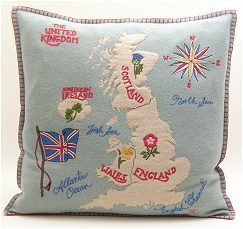
These lovely pillows from the Jan Constantine Collection can be found at Sugar and Spice Furnishings. Do be sure to browse for more English themed pillows on their site, as well as for charming cottage-type decorative items.
Or go directly to the Jan Constantine website for even more London themed gifts
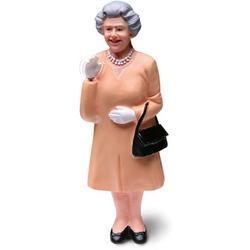
Everyone needs a solar powered waving QEII figurine, available from Findgift.com, who also purveys Xmas ornaments and a wide range of other British themed goods.
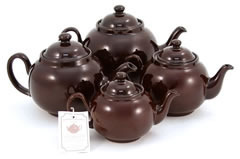 At Thebritishshoppe.com you'll find everything for the tea drinker on your list, including authentic Brown Betty teapots, sugar tongs and strainers.
At Thebritishshoppe.com you'll find everything for the tea drinker on your list, including authentic Brown Betty teapots, sugar tongs and strainers.
Don't forget the digestives!
The distinctly British motto on this apron from Decorative Things can be applied to tasks in the kitchen, as well as to life in general - Keep Calm and Carry On.
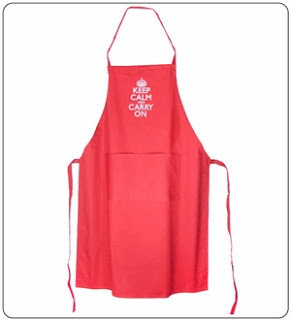
Or be very naughty and order yourself a tee that's fit for a queen from Cafe Press

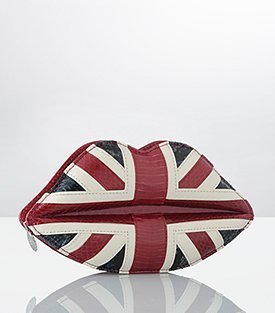
As every girl knows, the perfect handbag is a must, at Christmas or any time. Drop by Harrod's and snap up this padded Union Jack Lips clutch by LuLu Guiness at a price just shy of four hundred pounds. While you're there, pick up this tin filled with biscuits in the shapes of iconic London landmarks.
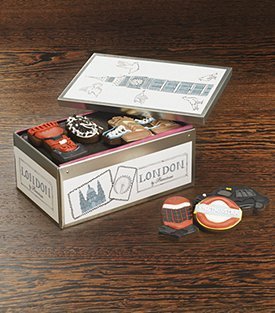
If you want to make a larger splash, opt for the Mayfair Hamper below from Fortnum and Mason At a cost of close to $500, you or your gift recipient will receive, among other things: Champagne Truffles, PicKadilly Blend Coffee, Gigantissimi Florentines, Regent's Blend Tea, Vintage Champagne, Claret Jelly, Pedro Ximenez Sherry, a bottle of St Emilion, a bottle of Sancerre Blanc, Goose Foie Gras en Gelée, 200g Valencay and Green's Cheddar, all of which is of course presented in a traditional wicker basket.
At a cost of close to $500, you or your gift recipient will receive, among other things: Champagne Truffles, PicKadilly Blend Coffee, Gigantissimi Florentines, Regent's Blend Tea, Vintage Champagne, Claret Jelly, Pedro Ximenez Sherry, a bottle of St Emilion, a bottle of Sancerre Blanc, Goose Foie Gras en Gelée, 200g Valencay and Green's Cheddar, all of which is of course presented in a traditional wicker basket.
At The Royal Collection Online Giftshop you can shop for items inspired by the Royals or by the various Palaces. There's china inspired by the Great Exhbition . . . .
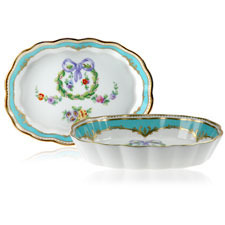 Grape scissors . . . . .
Grape scissors . . . . .
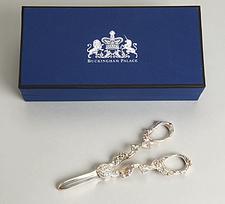
and books, videos and exhibition catalogues galore.
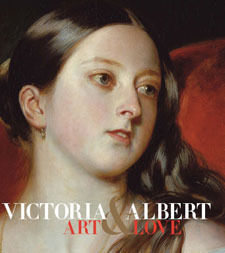
Booklovers on your list will be a snap to shop for with these suggestions, all available from the Signals catalogue.
For the Jane Austen lover . . .
The Jane Austen Collection Audios
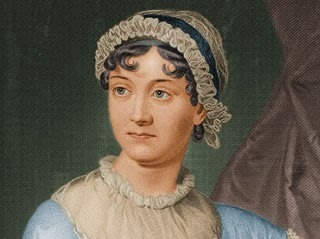
It is a truth universally acknowledged that Jane Austen's novels are delicious read aloud. Sit back and listen to five great novels and a short story read by some of England's top actresses: Joanna Lumley (Absolutely Fabulous), Belinda Lang (Inspector Alleyn), Anna Massey, and Harriet Walter. Set includes Pride and Prejudice, Sense and Sensibility, Emma, Northanger Abbey, and "The Watsons." Abridged. 15 hours on 12 CDs in a compact box. T-shirt or sweatshirt for the avid booklover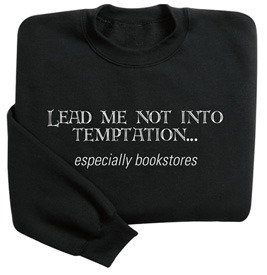 and one for the author in your life
and one for the author in your life

and finally, the absolutely perfect gift for everyone at Number One London -
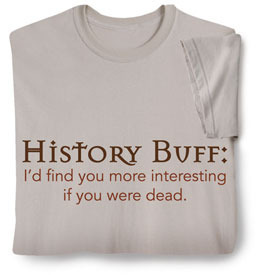
Need even more inspiration? Look for Part Two of our gift guide coming soon!


These lovely pillows from the Jan Constantine Collection can be found at Sugar and Spice Furnishings. Do be sure to browse for more English themed pillows on their site, as well as for charming cottage-type decorative items.
Or go directly to the Jan Constantine website for even more London themed gifts

Everyone needs a solar powered waving QEII figurine, available from Findgift.com, who also purveys Xmas ornaments and a wide range of other British themed goods.
 At Thebritishshoppe.com you'll find everything for the tea drinker on your list, including authentic Brown Betty teapots, sugar tongs and strainers.
At Thebritishshoppe.com you'll find everything for the tea drinker on your list, including authentic Brown Betty teapots, sugar tongs and strainers. Don't forget the digestives!

The distinctly British motto on this apron from Decorative Things can be applied to tasks in the kitchen, as well as to life in general - Keep Calm and Carry On.

Or be very naughty and order yourself a tee that's fit for a queen from Cafe Press


As every girl knows, the perfect handbag is a must, at Christmas or any time. Drop by Harrod's and snap up this padded Union Jack Lips clutch by LuLu Guiness at a price just shy of four hundred pounds. While you're there, pick up this tin filled with biscuits in the shapes of iconic London landmarks.

If you want to make a larger splash, opt for the Mayfair Hamper below from Fortnum and Mason
 At a cost of close to $500, you or your gift recipient will receive, among other things: Champagne Truffles, PicKadilly Blend Coffee, Gigantissimi Florentines, Regent's Blend Tea, Vintage Champagne, Claret Jelly, Pedro Ximenez Sherry, a bottle of St Emilion, a bottle of Sancerre Blanc, Goose Foie Gras en Gelée, 200g Valencay and Green's Cheddar, all of which is of course presented in a traditional wicker basket.
At a cost of close to $500, you or your gift recipient will receive, among other things: Champagne Truffles, PicKadilly Blend Coffee, Gigantissimi Florentines, Regent's Blend Tea, Vintage Champagne, Claret Jelly, Pedro Ximenez Sherry, a bottle of St Emilion, a bottle of Sancerre Blanc, Goose Foie Gras en Gelée, 200g Valencay and Green's Cheddar, all of which is of course presented in a traditional wicker basket.At The Royal Collection Online Giftshop you can shop for items inspired by the Royals or by the various Palaces. There's china inspired by the Great Exhbition . . . .
 Grape scissors . . . . .
Grape scissors . . . . . 
and books, videos and exhibition catalogues galore.

Booklovers on your list will be a snap to shop for with these suggestions, all available from the Signals catalogue.
For the Jane Austen lover . . .
The Jane Austen Collection Audios

It is a truth universally acknowledged that Jane Austen's novels are delicious read aloud. Sit back and listen to five great novels and a short story read by some of England's top actresses: Joanna Lumley (Absolutely Fabulous), Belinda Lang (Inspector Alleyn), Anna Massey, and Harriet Walter. Set includes Pride and Prejudice, Sense and Sensibility, Emma, Northanger Abbey, and "The Watsons." Abridged. 15 hours on 12 CDs in a compact box. T-shirt or sweatshirt for the avid booklover
 and one for the author in your life
and one for the author in your life

and finally, the absolutely perfect gift for everyone at Number One London -

Need even more inspiration? Look for Part Two of our gift guide coming soon!
Published on November 16, 2010 02:12
November 15, 2010
The Return of Napoleon

Al Pacino is set to hit the big screen as everyone's favorite despot, Napoleon Bonaparte. According to The Hollywood Reporter, Pacino has been eager to play the infamous French emperor for years, and is now getting his chance by signing on to play Bonaparte in "Betsy and the Emperor," a film based on a children's book of the same name written by Staton Rabin.
Directed by John Curran ("The Painted Veil") from a screenplay by Brian Edgar, the independent film will be based on the true story of Lucia Elizabeth Balcombe, whose father was Napoleon's jailer during his exile on St. Helena. The two struck up a friendship and (as yet unproven) rumors flew that the exiled Emperor was romancing the teenager. The film may alternately be titled "The Monster of Longwood."
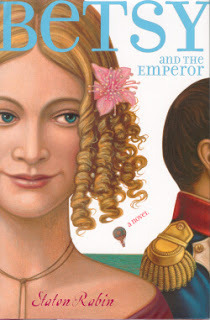
And it may ultimately have some competition, but that now seems doubtful. There's another film about Napoleon and Betsy in the works. Last April, "Harry Potter" actress Emma Watson had reportedly signed to play the lead in "Napoleon and Betsy," a version of the story written and directed by Benjamin Ross. That film languishes in pre-production while the two production companies fight their own Waterloo over rights to the story. For now, Pacino's version is scheduled to begin shooting this fall.
Published on November 15, 2010 01:33
November 14, 2010
Happy 62nd Birthday, Prince Charles
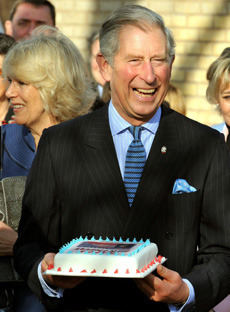
On this day a few years back Prince Charles became the oldest of all Princes of Wales since the title was attributed. In January 2008 Charles became the world's longest serving heir apparent, passing the record of 59 years and 73 days previously held by King Edward VII, when he succeeded his mother Queen Victoria and ruled for just nine years.
In 2008, a former aide told The Sunday Times, "Charles realised long ago that he would spend most of his life as heir, not as king. His is a family marked by longevity and his mother is in good health. He has made the most of it. He has enjoyed more freedom (than if he had been king) and achieved a tremendous amount in terms of charity and public life."
You can watch a CBS retrospective of the Prince and his wait for the throne that was broadcast on this day two years ago here.
Published on November 14, 2010 02:31
November 12, 2010
Regency Interiors - Do Not Try This At Home
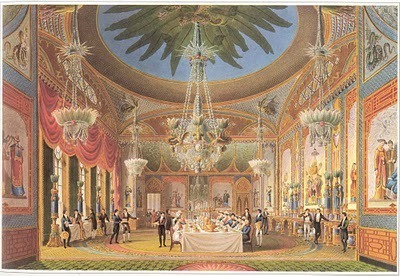
Interior, Royal Pavilion, Brighton
Ah, the Regency and it's interiors . . . a style so captivating that it's essence has been re-vamped, re-thought and re-invented to this day. In his quintessential book on the topic, Regency Style, author Steven Parissien writes, "The Regency was a marvelous period for the visual arts. It was a time in architecture when Palladian grandeur was fused with Neo-Classical academicism and with the vivid visions of gifted designers such as Soane and Hope. Colours were more exotic and vibrant than they had been for centuries . . . "
Nowhere was the Regency more exotic or vibrant than at George IV's Brighton Pavilion. Awash in period fabrics and paints and filled with global geegaws and every concievable architectural embellishment, it still stands as an ode to excess.
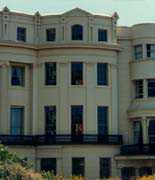
Regency interiors on a much more realistic level can be seen at the Regency Town House in Hove, above, where I had the pleasure of visiting and meeting Dr. Nick Tyson several years ago. The Regency Town House is a five storey, Grade 1 Listed, terraced house of the mid 1820's, designed by the Regency architect Charles Augustin Busby where Tyson heads a project to restore the townhouse to it's original period state. The partition walls were pulled down and the original features painstakingly repaired or replaced. Tyson and his team made visits to neighbouring houses on the Square to search for examples of the original ceiling roses, fireplaces and plasterwork.Their efforts included painstakingly stripping the paint from the walls, layer by layer, and dating each color until they reached the original, Regency paint. Here, Regency architectural elements exist, but they are on a much more realistic, and liveable, scale than those found at the Pavilion.
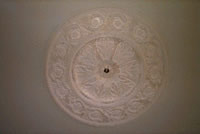 A restored ceiling rose at the Regency Town House
A restored ceiling rose at the Regency Town HouseArchitecture aside, Regency furnishings were defined by Egyptian, Chinese and Neo-Classical influences - a fact which 20th - 21st century interior designers either never knew or choose to forget. The term "Regency" as applied to design has become distilled. Today, "Regency" is a designation applied to hotels, dry cleaners, limo services and a host of other businesses in the hopes of giving them a little class. In design, the essence of what defines the Regency has been re-interpreted through the years and all but vanished. The Hollywood Regency style was characterized by high glamour and glitz and emerged through the work of interior designers the likes of Dorothy Draper, Elsie de Wolfe, and William (Billy) Haines, who in the 1930's decorated the homes of movie stars during Hollywood's Golden Age.
In the 1930's, Dorothy Draper took on a design project at Hampshire House, an apartment building located at Central Park South in New York, where she installed a mix of English and Italian baroque styles throughout, while adding oversized black and white doors, plaster reliefs carved in the ornate style of Grinling Gibbons and, of all things, chairs that look like nothing so much as modified Hall Porter's chairs.
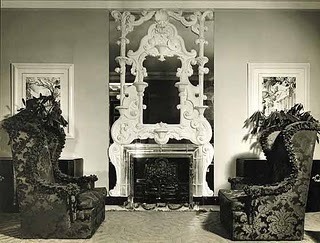
In fact, a few years back, decorators collectively took to installing Hall Porter's chairs everywhere - including restaurants, such as that located within Bergdorf Goodman in New York, below.
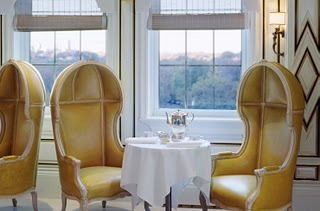
In one of my parallel careers (magazine editor, travel writer, food critic), exactly which I cannot now remember, I reviewed a restaurant located within a Miami Beach hotel. It had just been revamped and the decorator had opted to use Hall Porter's chairs as seating at some of the tables. After approving my review, the hotel's PR person called to ask if I could change the phrase Hall Porter's chair to Porter's hall chair in the text. She thought it sounded better and that's the term their decorator had used. I told her (emphatically) that I could not. And why. I did not tell her that her decorator obviously had no idea what a Hall Porter's chair was, how it had been employed, much less why it was designed as it was -with it's curving wing backs - in order to keep draughts off the heads and necks of the servants who had to sit in it all night long so as to be ready to open the door when their masters arrived home late at night. The fact remains that a Hall Porter's chair was a piece of furniture meant to be used by a servant and no self respecting Regency homeowner would have used them otherwise. They certainly would not have felt honoured if made to sit in one whilst eating their dinner.
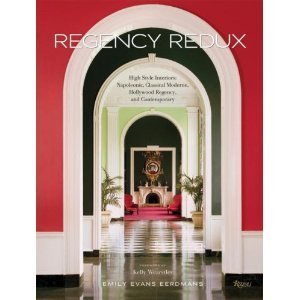
Nowadays, there has evolved yet another incarnation of the Regency design - Vogue Regency. And a 2008 book called Regency Redux: High Style Interiors: Napoleonic, Classical Moderne, and Hollywood Regency written by Emily Evans Eerdmans attempts to explain the various incarnations of Regency style through the 1940's.
What remains inexplicable is why designers do not avail themselves of comtemporary sources, beginning with Rudolph Ackermann, in order to get the basis for their designs right. I suppose I might not be so aghast at some in the design world reinterpreting Regency style if they had any idea of the actual origins of the concept. Porter's Hall chairs . . . . I ask you!
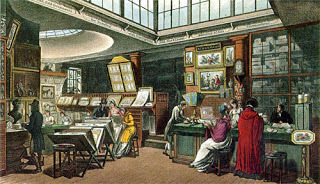
Published on November 12, 2010 01:54
November 10, 2010
An Account of a Duel at Bath
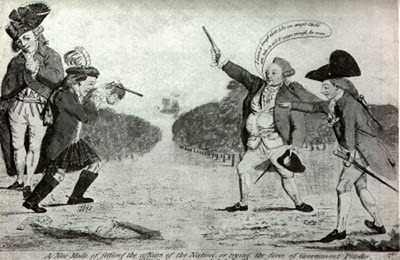
The following is an extract from "Extraordinary Popular Delusions and the Madness of Crowds" by Charles Mackay (1841):
A barbarous and fiercely-contested duel was fought in November 1778, between two foreign adventurers, at Bath, named Count Rice and the Vicomte du Barri. Some dispute arose relative to a gambling transaction, in the course of which Du Barri contradicted an assertion of the other, by saying, "That is not true!" Count Rice immediately asked him if he knew the very disagreeable meaning of the words he had employed. Du Barri said he was perfectly well aware of their meaning, and that Rice might interpret them just as he pleased. A challenge was immediately given and accepted. Seconds were sent for, who, arriving with but little delay, the whole party, though it was not long after midnight, proceeded to a place called Claverton Down, where they remained with a surgeon until daylight. They then prepared for the encounter, each being armed with two pistols and a sword.
The ground having been marked out by the seconds, Du Barri fired first, and wounded his opponent in the thigh. Count Rice then levelled his pistol, and shot Du Barri mortally in the breast. So angry were the combatants, that they refused to desist; both stepped back a few paces, and then rushing forward, discharged their second pistols at each other. Neither shot took effect, and both throwing away their pistols, prepared to finish the sanguinary struggle by the sword. They took their places, and were advancing towards each other, when the Vicomte du Barri suddenly staggered, grew pale, and, falling to the ground, exclaimed, "Je vous demande ma vie." His opponent had but just time to answer, that he granted it, when the unfortunate Du Barri turned upon the grass, and expired with a heavy groan. The survivor of this savage conflict was then removed to his lodgings, where he lay for some weeks in a dangerous state.
The coroner's jury, in the mean while, sat upon the body of Du Barri, and disgraced themselves by returning a verdict of manslaughter only. Count Rice, upon his recovery, was indicted for the murder notwithstanding this verdict. On his trial he entered into a long defence of his conduct, pleading the fairness of the duel, and its unpremeditated nature; and, at the same time, expressing his deep regret for the unfortunate death of Du Barri, with whom for many years he had been bound in ties of the strictest friendship. These considerations appear to have weighed with the jury, and this fierce duellist was again found guilty of manslaughter only, and escaped with a merely nominal punishment.
Published on November 10, 2010 01:29
November 9, 2010
Curiosity Corner - We Have a Winner!

Diane Gaston is the winner. Oh, Lord, Diane. I know just how you found out and I could kick myself. Sigh. You're the winner, no matter how devious your methods. A wine cork retriever it is. And you can bet I won't make THAT mistake again! Email me your snail mail and I'll get the dvd out to you pronto. . . good guesses, Kat! Thanks for playing everyone!
The first person to correctly identify this item will win a DVD of the Amanda Root/Ciaran Hinds version of Persuasion. Please place your guess by using the "comments" link below this post.
Please Note: Only registered followers of this blog shall be eligible to win. You may register now by using the link in the right sidebar under "Those Who Call Number One London Home."
Good Luck!
Published on November 09, 2010 04:38
Curiosity Corner

What is it?
The first person to correctly identify this item will win a DVD of the Amanda Root/Ciaran Hinds version of Persuasion. Please place your guess by using the "comments" link below this post.
Please Note: Only registered followers of this blog shall be eligible to win. You may register now by using the link in the right sidebar under "Those Who Call Number One London Home."
Good Luck!
Published on November 09, 2010 04:38
November 8, 2010
London A - Z
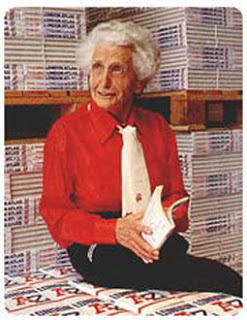
The London A-Z, that indispensable guide to the streets and landmarks of the City, has been used by countless numbers of people seeking to navigate London's streets. Everyone has heard of the London A-Z, though most have no clue as to it's origins.
Meet Phyllis Pearsall - the eccentric British artist who single-handedly mapped London's A-Z and created a publishing phenomenon. Born Phyllis Isobella Gross, her lifelong nickname was PIG. The artist daughter of a flamboyant Hungarian Jewish immigrant, and an Irish Italian mother, her bizarre and often traumatic childhood did not keep her from becoming one of Britain's most intriguing entrepreneurs and self-made millionaires. Pearsall was left to her own devices as a teenager, especially after her father had gone bankrupt and fled to the U.S. Pearsall herself told an interviewer that one day soonafter, she returned home to find the door was answered by the fully decked-out Maharajah of Patiala, who was in the midst of having his portrait painted by Alfred Orr, Phyllis's mother's lover. ''Then mother said: 'Alfred has an artistic temperament and couldn't possibly have a little girl in the house. Get a live-in job,' '' Mrs. Pearsall related.
Displaying much pluck, at the age of 14 Pearsall went to France to teach English at a girls school at Fecamp. With French as her second language she went on to study at the Sorbonne in Paris, always living on the edge of poverty, sleeping on the street under a newspaper blanket and drying her laundry on library radiators.
Eventually earning a meagre living by painting portraits and writing articles for various magazines and newspapers, Pearsall returned to England and in 1926 met and married Richard Pearsall. The marriage lasted for about eight years, during which time she had established a reputation for her writing and for her etchings and painting and the couple moved to Spain. Eight years later, the 30-year-old Pearsall became a divorcee, returned to London and turned to full-time portrait painting in order to support herself.
Some accounts say that it was the difficulty Pearsall had in finding the homes of her portrait sitters in London that prompted her to create the A-Z. Others that she couldn't find the address of a party she wanted to attend in Belgravia. Still other accounts relate that Pearsall's father, Alexander Gross, wrote to ask her to publish in England a map of the world produced by the map company he'd built in the United States - after losing the map company he had originally established in Fleet Street. Reluctantly she agreed, and had to learn all the technical jargon involved in reproduction and printing before setting about selling direct to the customer. It was on one of these selling expeditions that she got lost because of the out-of-date London street map she was using. This was the beginning of her idea of how useful an up-to-date map would be - a map that all could use for business and pleasure.
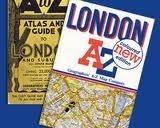
Without hesitation she covered London's 23,000 streets on foot during the course of one year, often leaving her Horseferry Road bedsit at dawn. Pearsall collected street names, house numbers along main roads, bus and tram routes, stations, buildings, museums, palaces etc, in addition compiling the street index in alphabetical order.To publish the map, and in light of its enormous success, she set up her own company, The Geographer's Trust, which still publishes the London A-Z and that of every major British city. The first A-Z was published in 1936. She abandoned the traditional design of the large fold out map in favour of a book format where each page was a small section of a large-scale map. All of the streets were coded to enable them to be referenced, indexed and searched for. Pearsall printed 10,000 copies of her maps, selling them as indefatigably as she had compiled them. She persuaded a reluctant buyer at W. H. Smith, the British bookseller, to place an order for 250 copies, promising a refund if they went unsold. The maps were an instant success, and have sold countless millions of copies since.
Pearsall ran her publishing company successfully for many years and reported to work well into her 80's, arriving in a red Mercedes that she bought at the age of 59, when she passed her driving test after taking more than 200 lessons. Mrs. Pearsall wrote several books, including an account of her trips through Spain, a collection of short stories, a company history and a volume describing her business philosophy, in which she advocated generosity (''bonuses to everyone''), courtesy (''no aggressive selling'') and frugality (''Micawber housekeeping''). In 1986 she was made a Member of the British Empire. Phyllis Pearsall died at Shoreham-by-Sea, Sussex on 28 August 1996 at age 89. What a dame.
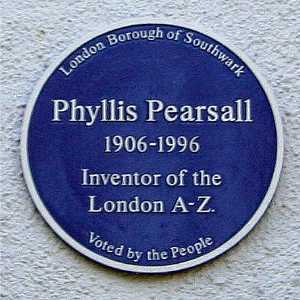
Blue Plaque at Pearsall's former home in Court Gardens Lane, London
To read further on the subject, we suggest Mrs.P's Journey: The Remarkable Story of the Woman Who Created the A-Z Map by Sarah Hartley.
Victoria here, chiming in to remind readers of the historical A to Z series, of special value to researchers and writers. You can acquire them from several sources - just Google it. I bought my copy of The A to Z of Regency London at the Guildhall in the City of London. Good research library there too! The six versions of the A to Z's of historic London are: Elizabethan, Restoration, Georgian, Regency, Victorian and Edwardian. Make your choice(s) according to the focus of your interests.
Here is the London Topgraphical Society description: "Our A to Z series consists of six books, which provide fully-indexed maps of London at roughly 100 year intervals. Each reproduces a key map of the period. The indexes allow users to identify the position of streets and buildings, in some cases right down to small courts and alleys. They appeal to anyone interested in the development of London and are invaluable for those researching family history. The A to Z volumes are published in association with Harry Margary and the Guildhall Library."
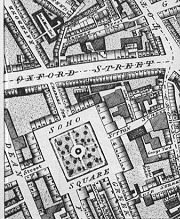 Section of the Map from
Section of the Map from 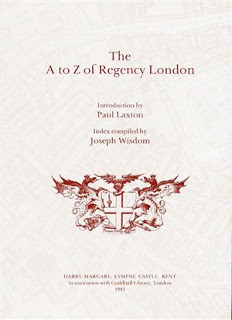 The A to Z of Regency London
The A to Z of Regency London
Published on November 08, 2010 02:21
November 7, 2010
Will They or Won't They?
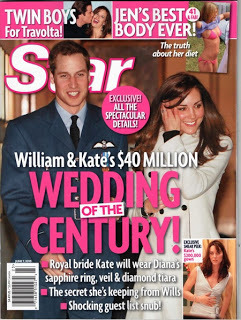
Amazing, is it not, how the Star already knows what Kate will be wearing when she marries Prince William when the rest of the world didn't even hear that they'd become engaged? William and Kate: A Royal Love Story premiers tonight at 10 p.m. on TLC and seeks to answer that burning question - when is Prince William going to get engaged to Kate Middleton? TLC's press release reads:
"Showcasing the definitive love story between a Prince who will be King and the woman who may one day be his Queen, this brand new documentary unveils Prince William and Kate Middleton's intriguing royal courtship that began in college eight years ago. Theirs is an unlikely story – Kate is an attractive young woman, but grew up well outside the realm of royalty. William is the embodiment of centuries of royal breeding and tradition. As he is being groomed for kingship with Kate at his side, this special reveals the added pressures William will face as he is expected to restore the reputation of the tarnished House of Windsor, a royal house severely damaged by his parents' broken marriage and his mother Princess Diana's untimely and tragic death."
One would think that TLC, and the press at large, would have learned their lesson by now and, in order to avoid a repeat of the mad dog-like press attention given to Diana, they'd lighten up on William. But as he's the future king, that's doubtful. And to be honest, if they put the show on t.v., we'll watch it.
In my opinion, William's got an even tougher road to hoe than his father, Prince Charles. For the most part, the world has given up on Charles being an effective king. He's dismissed as being a tree hugging, adultering whacko or it's assumed that he'll be too old to be of any real use once he assumes the throne and that his reign will just have to be got through until the reins are passed to William. In addition, Charles is too closely associated with all the scandals and drama of the past few royal decades. William, poor devil, is seen by some as the last hope for restoring the cache of the monarchy. Personally, I think Charles will make a fine king. One has only to recall the words of the Duke of Wellington, who said that the sons of King George III were "the greatest millstone ever hung round the neck of government" to see that as Prince of Wales, Charles is a vast improvement over Prinny. I'd much rather have a Prince who is too green than one who is too purple.
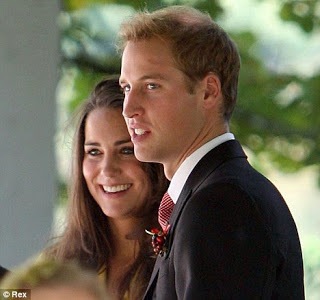
Like they did with his father and mother, the press are touting William and Kate's courtship as a fairy-tale romance. One can only hope that this pair will live happily ever after. In addition to the press, Ladbrokes is also getting in on the proposal action, speculating that Prince William is most likely to propose in December and making, offering 7/4 odds that that's when Clarence House will officially announce his engagement to Kate Middleton. Meanwhile, rival bookmakers Paddy Power make the first two Saturdays in August the likeliest for a Royal Wedding. The bookmakers have already paid out on a Royal Wedding in 2011 and it's a question of which 13th August 2011 as the date likeliest for the couple to be spliced, with odds of 3/1 about the wedding taking place that day.
Alas, while abhoring the possibility that the young lovers will be beset by the media, and the bookies, the moment they announce their engagement, I'll also be watching TLC tonight at 10 p.m. Well, okay, I'll be flipping back and forth between that and Sherlock Holmes on PBS . . . does the fact that I have absolutely no intention of betting on the Royal nuptials mitigate things at all?
Published on November 07, 2010 01:42
November 6, 2010
The Death of Princess Charlotte
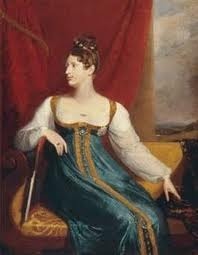
Princess Charlotte Augusta of Wales (b. 7 January 1796 d. 6 November 1817) Had she lived, Charlotte would have been Queen of the United Kingdom.
Princess Charlotte Augusta of Wales was the only daughter of George IV, then Prince of Wales, and his wife and first cousin, Caroline of Brunswick, who loathed one another and who separated soon after Charlotte's birth, never to live together, nor indeed be civil to one another, again.
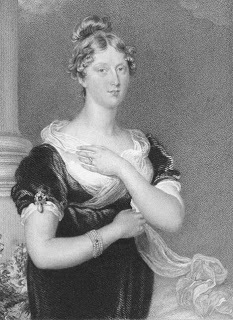
A protracted battle of wills went on for years concerning Princess Charlotte. The prince was willing to accede to the wishes of his father, King George III, but wanted Caroline to have no influence in her daughter's education, while the king wanted Queen Caroline to be party to decisions about her daughter. In the end, Charlotte remained in the care of her father and the the Princess of Wales was forbidden to see her daughter and in 1799 she went abroad, inviting scandal by taking lovers and running up vast debts.
When Charlotte reached a marriageable age in 1813, the Regent engaged her to the Prince of Orange, whom she loathed, in December. Having served under Wellington (whose set referred to the Prince as "Silly Billy"), and been educated in England, he was eligible as a husband but his residence in Holland, owing to his father's return from exile to the throne, became a necessity. Princess Charlotte was not happy. Not only did she not want to leave England, but she saw this as a means for her father to get her out of his hair. Things had not been going smoothly for some time, as mentioned in a prior post on this blog. Charlotte asked that the marriage treaty contain a clause to the effect that she should never be obliged to leave England against her will and told Prince William that her duty to England was 'such as to make even a short absence inconvenient and painful.'
The following is from a book called The Beloved Princess: Princess Charlotte of Wales by Charles E. Pearce -
The Regent was bent upon hurrying the courtship. He came to see Charlotte the next day, bringing with him the Prince of Orange, whom Miss Knight further describes as "particularly plain and sickly in his look, his figure very slender, and manner rather hearty and boyish." A more unsuitable mate for the robust, impulsive, and warm-blooded Charlotte could hardly be imagined, and if there was any love-making on this occasion it must have been of the most vapid and uninteresting kind. At all events, the young man had the opportunity, for the Regent turned aside, leaving the two together, and sat by the fire chatting to Miss Knight in an adjoining room. The object of the chat was to make it known to the lady companion that the Princess Charlotte was engaged to the young Prince, but that Miss Knight was to tell no one until he gave her leave. The Regent evidently had his doubts as to Charlotte's real sentiments, for he desired Miss Knight to give her good advice, particularly "against flirtation."
These doubts were soon confirmed, for while he was talking the conversation was interrupted in rather an embarrassing fashion. The Princess was suddenly heard sobbing hysterically. The Regent started to his feet, and Miss Knight followed him to the door of the other room, where they found the Prince of Orange looking very frightened and Princess Charlotte in great distress.
" What, is he going away ? " exclaimed the Regent.
The question could only have been put in a bantering spirit. He saw something was amiss, but he did did not trouble to inquire further, and soon after took the Prince away, as they had an engagement to dine in the City.
When they were gone Charlotte explained what had caused her outburst of emotion. The Prince had told her it was expected she should reside every year two or three months in Holland, and even when necessary follow him into the army; that the Regent and his Ministers had not thought it advisable to tell her this, but that, as he always wished they should be open and fair to each other, he was resolved to tell her.
The announcement descended upon her like a thunderbolt. Apart from the humiliating thought that the father and the Ministers were plotting to keep her in the dark, there was also the suspicion that they wanted to banish her from England.
It can hardly be doubted that Charlotte had secret ambitions to fulfil the high station which fate had apparently designed for her. If at any moment the Regent died, she would be Queen of England. She could then marry any one she pleased.
Charlotte certainly never pretended to have any affection for the Prince of Orange, and did not hesitate to ridicule him even after their betrothal. She told her mother that his being approved of by the Royal Family was quite sufficient to make him disapproved of by her; for that she would marry a man who would be at her devotion, not theirs. "Marry I will," said she to the Princess of Wales, "and that directly in order to enjoy my liberty, but not the Prince of Orange. I think him so ugly that I am almost obliged to turn my head away in disgust when he is speaking to me." The engagment, for various reasons, ended in 1814.
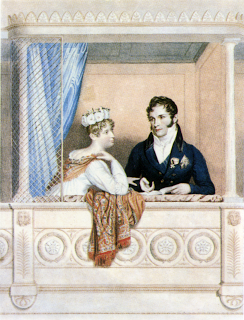
In the end, Charlotte was married to Leopold George Christian Frederick of Saxe-Coburg-Saalfield, (above) her own choice as a husband. Leopold was the youngest child of Francis, Duke of Saxe-Coburg-Saalfeld and Augusta of Reuss-Ebersdorf. The couple were married on 2 May, 1816, at Carlton House. After spending their honeymoon at Oatlands in Surrey, the country seat of her uncle, the Duke of York, the couple set up home at Claremont. The cool and collected Leopold was to prove a calming influence on his tempestuous and headstrong wife and life was idyllic for the couple.
However, in 1817, after two miscarriages, Charlotte became pregnant with what was hoped would be a grandson and the heir in the next generation to the British throne.
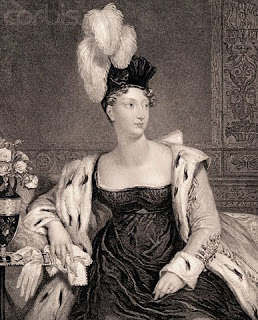
Once again we turn to The Beloved Princess: Princess Charlotte of Wales -
Princess Charlotte's persistent ill-luck mysteriously pursued her to the last. When she was expecting to crown her hopes and those of her husband, and the question of her medical attendant became of importance, her intimate friend Lady Ashworth urged her to have Sir William Knighton, an accoucheur of some eminence. The matter was apparently settled, and Lady Ashworth went away to Rome. When she returned she found, to her dismay, that the Princess had, upon the advice of a lady, decided to appoint Sir Richard Croft. It was too late to alter the arrangement, and Croft, a pompous, vain, and selfopinionated man, entered upon his duties. Stockmar, who was part of the household at Claremont, describes him as " a long, thin man, no longer very young, fidgety and good-natured, seems to have more experience than learning or understanding." Croft had a craze for lowering the physical strength of his patients, and this suicidal course was pursued with the Princess Charlotte. Miss Murray tells that the Princess was accustomed to have a mutton-chop and a glass of port for lunch. Croft did away with this, and substituted tea and bread and butter. She became weak and depressed, and one day a friend found her in tears. This mistaken treatment was continued for weeks. The calibre of Croft's mind can be guessed from his foolish remark in reference to his suggestion that the Princess should wear no stays : " A cow does not wear stays, why should the Princess Charlotte?"
Her life was thrown away, for when the supreme moment was at hand, weak as she was, she was unsustained for fifty hours by any kind of nourishment in the way of food ; the obstinate and self-deluded accoucheur thinking it much better that she should not eat. The baby—a boy of unusual beauty—was born. It was dead, and Croft tried to bring back life, but in vain. Meanwhile the mother was left to herself, for the accoucheur refused to have any other doctor present. Not even any of Charlotte's ladies were with her, only the nurse.
The child was born at nine o'clock, and apparently the mother was going on fairly well, but towards midnight Croft became alarmed and went for Stockmar, telling him the Princess was dangerously ill and that the Prince must be informed. Leopold knew that the child was dead, but he did not realise the nature of the impending calamity. It was all over when he set out for her room, and on his way he sank on a chair overwhelmed. Recovering himself, he staggered on, reached the bedside, and kneeling down kissed the cold hands—" those beautiful hands which at the last while she was talking to others seemed always to be looking out for mine," were his pathetic words—and amid the stillness of death the falling curtain closed upon the tragedy.
Though the mother seemed at first to be recovering well from her horrendous ordeal, she complained that evening of severe stomach pains and began to vomit. She later developed a pain in her chest, before going into convulsions. Soon after the Regent was awoken by his brother, the Duke of York and informed that his only daughter was dead.
The following details of the Princess's death are taken from a letter, addressed by Mr. H. F. Cooke to Mr. Thomas Raikes (under date November 6, 1817), and published in the interesting volume entitled The Correspondence of Thomas Raikes with the Duke of Wellington and other Distinguished Contemporaries.
" The Princess Charlotte's death has caused a general gloom throughout the country. The particulars of this truly melancholy event will be made known to you through the papers, with all the accuracy of official report.
There are some few circumstances as attending the death of this interesting woman that may not find their way abroad; for example, the courage with which she suffered, and the resignation which she displayed in death. The faculty of mind never abandoned her. She asked, about an hour previous to death, whether there was any danger: the difficulty of breathing from about that time prevented her speaking much. When Baillie and Croft administered brandy, hot wine, sal-volatile, &c, she said, ' You make me drunk. Pray leave me quiet. I find it affects my head.' And shortly after this, raising herself in the bed, she heaved a deep sigh, fell back, and expired.
"The act of dying was not painful. There certainly must have been spasm, but I have not heard that it was at the heart. Neither do I believe the family conceived that she was in danger, even an hour before she died. It is a blow which the nation really appears to feel acutely, as much as it is possible to suppose the fate of any one not materially connected with one could be felt.
"The Regent is terribly shook by this blow; so unexpected that he was completely overset when he was told of it. He had left Sudboum upon hearing of the protracted labour, but was in London informed that the child was dead and she remarkably well."
Indeed, a deep and black mourning was proclaimed as soon as the Prince Regent and the country learned of the death of Princess Charlotte. No one was more bereft than Prince Leopold.
In her letters, Lady Shelly wrote, "To-day the Duchess of York goes into the country to receive the unhappy Prince Leopold of SaxeCoburg, whose grief is as deep as during the first. He spends some hours every day in the bedchamber of Princess Charlotte. That apartment is still as it was when the Princess left it the day before she died! Her pelisse, her boots, and even her hat, which she had carelessly thrown aside on the sofa, are left just as they were, for no one but the heart-broken Prince has entered that room. It is a case of real grief, and absolutely without parade."
An austopsy was conducted upon the Princess and, at the time, it was believed that her death was due to a post-partum hemorrhage after giving birth to a stillborn son. Modern day doctors who have examined the autopsy findings now tend to believe that the Princess died from a pulmonary embolism.
Blackwood's Magazine offered the following account of the events in the days following Charlotte's death -
Yesterday the mourning for the much lamented Princess Charlotte commenced in this city, and was very general. The pulpits and desks of all the churches were hung with black. . . In the fore preserved in a similar manner to that of its royal mother, (the child) by being secured in several wrappers round the whole of the body, with light bandages, and being secluded, by means of wax, from the air, it will remain in a perfect state of preservation for a number of years. The whole of the body is enclosed in blue velvet, tied with white ribbons.
Windsor, Nov. 19—This morning, a little before one o'clock, the funeral procession with the remains of the late universally-regretted Princess Charlotte, arrived here from Claremont. They were received at the lower Lodge, where she is to lie in state this day, previously to the interment at night. The mourning coach, in which were the infant and urn, proceeded to the chapel, where eight yeomen of the guard, in attendance, carried and deposited them in the vault. The procession of the hearse and five mourning coaches, preceded by a number of men on horseback, was escorted into the town from Egham by a party of the Royal Horse Guards. Although the hour at which it arrived was so very late, the road and streets through which it passed were lined with spectators.
Funeral of the late Princess Charlotte - The last sad and solemn rites have been paid to the mortal remains of the lamented Princess Charlotte of Wales. It was near two o'clock before the procession arrived at Windsor. The remains of the Princess were received at the lower Lodge by a party of the yeomen of the guard, who carried the coffin. A guard of honour from the 3d regiment of Foot Guards, who are quartered at Windsor, was stationed on the outside of the lodge. Prince Leopold, his attendants, and others, in the mourning-coaches, alighted at the lodge. The anti-room was hung with black cloth, and the interior chamber, in which the coffin reposed, was entirely lined with the same . . . The coffin was covered with a large black velvet pall, with a deep white border that fell on each side, and spread itself on the floor. On the coffin was the Princess's crown, and at the head of the coffin, against the wall, was a large escutcheon of silk, similar to those placed on the fronts of houses when death has taken place in a family. Three large wax candles were on each side of the coffin; numerous small wax candles were burning on all sides of the room—The gentlemen of the College of Arms were busily employed during the morning in arranging the stalls in the chapel for the reception of the Knights of the Garter, and in other preparations for the funeral. The machinery for letting the corpse down into the vault was completed. —Windsor continued crowded to excess throughout the day. At dusk, it was thought necessary to clear the Castle Yard, and none were afterwards admitted without pass-tickets. The 1st, 2d, and 3d regiments of Guards took a principal part of the duty. The door opened a few minutes before seven, and those who had tickets were admitted into the grand entrance of that superb edifice. By half past eight all was ready, and the funeral cavalcade was put in motion. Proceeding at half-foot pace, it was nine o'clock when it reached St George's Chapel. At eight o'clock each fourth man of the Royal Horse Guards lighted a torch. About half past eight the procession began to move from the lower lodge.
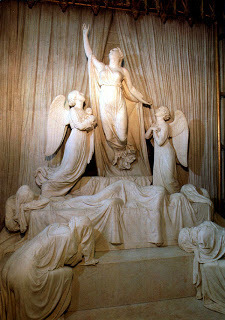 This memorial to Princess Charlotte and her son stands in St. George's Chapel, Windsor
This memorial to Princess Charlotte and her son stands in St. George's Chapel, Windsor The moon shone with peculiar brightness during the whole time. The procession entered by the gate on the south aisle of the chapel, through which it proceeded, and moved up the nave into the chapel. The aisle on each side was lined by a detachment of the Foot Guards, three deep. It is but pure justice to the assembled soldiery to say, that they conducted themselves with the most exemplary conduct, and evinced their full participation in the anguish and distress of their fellow-citizens. Prince Leopold followed the coffin as chief mourner. He walked along with unsteady step, and took the seat provided for him at the head of the coffin, between the Dukes of York and Clarence. The coffin was placed with the feet towards the altar. The usual anthems were chanted with proper solemnity; but the reading part of the ceremony did not attract any particular observation; the Dean went through his portion of it with dignity and pathos. When it was over, Sir Isaac Heard read the titles of the Princess, in a voice much more broken by grief than age, and the mourners walked back, though without the state accompaniments. The Prince Leopold looked distressingly ill; and indeed his state of health and feeling might excite alarm, if it were not that he has latterly been able to procure some sleep. The melancholy business was over before eleven o'clock, but the chapel and the avenues were not completely cleared till twelve o'clock. The baronesses who bore the pall were Ladies Grenville, Ellenborough, Boston, and Arden.
Below are a few examples of the momento mori connected to Princess Charlotte.
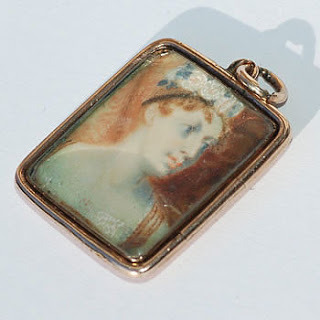
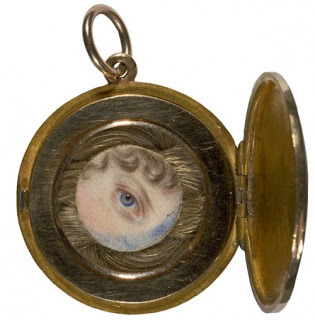
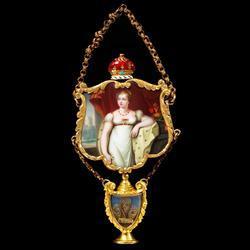
Further reading: Royal Mourning and Regency Culture: Elegies and Memorials of Princess Charlotte by Stephen C. Behrendt, Palgrave Macmillan, 1997, ISBN 9780312210496, 282pp.
Published on November 06, 2010 03:11
Kristine Hughes's Blog
- Kristine Hughes's profile
- 6 followers
Kristine Hughes isn't a Goodreads Author
(yet),
but they
do have a blog,
so here are some recent posts imported from
their feed.



